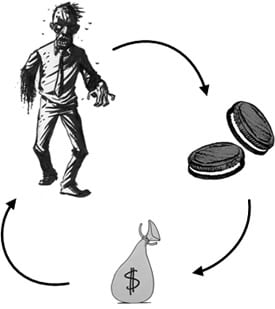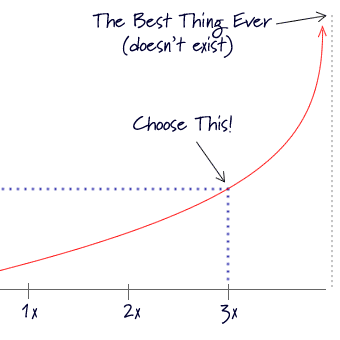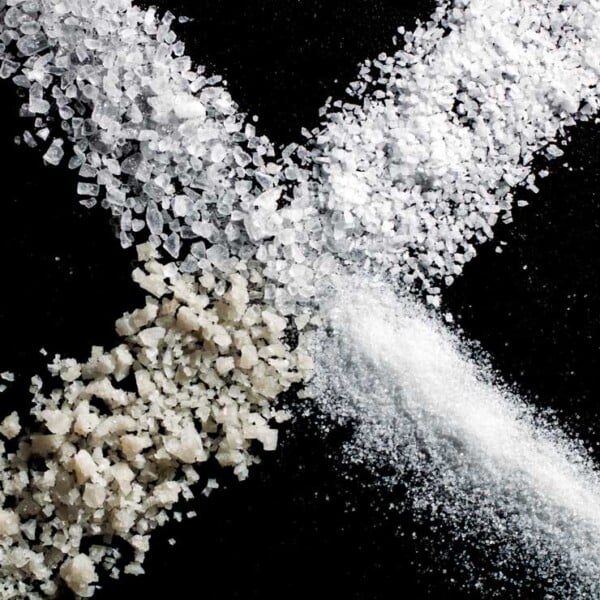Zombies, Processed Foods, and the Advertising-Consumption Cycle
Oct 08, 2011, Updated Jun 18, 2014
Daniel Koontz is the author of Casual Kitchen, a blog helping readers cook more, think more, and spend less. Last year he gave us his thoughts on The 80/20 Rule, and today he shares another important — and empowering — idea. Oh yeah, and there’s something about zombies, too.

There’s an entire stack of costs involved in getting packaged and processed foods into the hands of consumers. Take Oreo cookies for example — uh, exactly the kind of food we’re trying to avoid here at October Unprocessed. Baked into every box of Oreos are ingredient costs, processing costs, packaging and transport costs, advertising and marketing costs, and so on.
All else equal, if a company wants to make money on what it sells, then the retail cost of that box of Oreos must equal the sum of all the various costs in that cost stack, plus a profit margin.
Okay. With that as a starting point, let me ask readers here at Eating Rules a question: What is, by far, the single biggest cost in the cost stack of almost all processed foods?
I’ll give you a big hint: It’s advertising and marketing.
In fact, when selling processed foods, almost all major food companies use a transparently simple, three-step business model based almost totally on advertising. Here’s how it goes:
1) Spend tons of money drowning consumers with repeated advertising and branding messages,
2) Charge those consumers a premium price when they shuffle mindlessly and zombie-like to the store to buy food products,
3) Repeat.
It may be simple, but this business model works well — exceptionally well. Some of the most successful and long-lived companies in modern economic history (Proctor & Gamble, Colgate-Palmolive, General Mills, Kellogg, Pepsi, just to name a few) use this model to earn juicy profit margins across recessions, depressions, booms and busts.
Here’s the thing, though. This advertising-consumption cycle works for one reason and one reason only: Because we as consumers enable it. Sure, the companies make the foods and run the ads — they’re the first part of this equation, obviously. But when we consumers pull our money out and buy these products, we complete the advertising-consumption cycle.
That’s why assuming that consumers are helpless victims under the boot of the food industry is not only inaccurate, it’s deeply condescending. It presumes that we are helpless zombies who can’t resist advertising. Despite the semi-facetious title of this post, most human beings are not zombies. I hope.
(However, if someone behind you in the grocery store moans “braaaiiinnnns” — run. Just in case.)
Here’s the conclusion. Now that we’re totally familiar with the hilariously simplistic, three-step business model above, we consumers know exactly what to do. We know food companies will run lots of ads and spend lots of money on branding, and we know they’ll try to sell processed foods to us at prices high enough to cover those advertising costs — and still earn generous profits. We the consumers end up paying for everything, including the ads, and often end up getting suspect food products in return.
That’s why, as consumers, we must adopt an entirely new philosophy of consumption.
When you see products being advertised, don’t be a zombie and passively ingest the message of the ad. Instead, develop the opposite instinct and avoid those products.
When you see an ad for cookies or branded, boxed cereal on national TV, or hear a processed food jingle played on the radio, think of the enormous cost of running those ads. Think of yourself paying for that ad — which is exactly what you do when you buy that product.
When you see a product or company sponsoring a major sporting event, or buying naming rights for a stadium, think about the enormous cost. You pay for that. A saturation print ad campaign? You pay. Billboards? You pay. Super Bowl ads? Yep, you pay.
As consumers, we need to change our response to the advertising-consumption cycle. Don’t let the food industry condescendingly assume you’re a zombie, dragging yourself to the grocery store to complete the advertising-consumption cycle. Change your mindset so that seeing ads makes you want not to buy.
Before long, you’ll start to see heavily advertised foods for what they really are: Destroyers of consumer value. You’ll have no problem instinctively avoiding them, and instead you’ll automatically seek out lower-priced, less-processed, and healthier foods instead.
If there’s one idea I’d like you take away from this post, it’s this: Advertising destroys value. Rethink how you react to advertising, and you’ll get far more value for the food you buy.
—
Illustration adapted under the creative commons license from Ferrabone Carlos’s Snarky Oreo, Mejuan’s Money Bags, and Shannon Hayward’s Killer Zombie.




















There are many other reasons to not support those companies – like the fact that their corporate sponsors have lobbied the USDA so much that organic standards are being diluted to make non-organic additives pass muster. I choose to simply not give anyone with deep corporate pockets any of my money.
Rachel, great question. I try to keep it simple: if they advertise enough such that I see their ads regularly in the media, I cut back on (or often totally eliminate) buying the product–and I will look for a non-advertised substitute that sells at a lower price.
DK
Great article! Here’s what I’m conflicted about … how do you feel about organic or “natural” processed foods (like Kashi, Annie’s, Barbara’s, etc.)? Do they follow the same advertising-consumption model? I know they don’t spend as much in advertising as, let’s say, Doritos, but many (if not most) of these brands are owned by the same corporations who make mainstream junk food. However, for those who don’t have (or make) time to make their own crackers, granola bars or other snack foods, they offer a healthier choice. Or do they? See, I told you, I’m conflicted!
If you’re curious which major corporations own which “natural foods” companies (hint: Kashi is now owned by Kellogg), take a look at this great infographic.
That doesn’t really answer your question, but it might help inform your thinking. Perhaps it’s worth considering the parent company and their advertising practices overall?
I’m grateful for the feedback so far. And I’m also grateful that my message resonates here at Eating Rules.
One extra comment I’d add, and I’d like to direct it to the many readers here who have your own blogs: Pass this message along to your readers, and show them how to take their power by showing them that they have a choice. They can either “complete the circle of consumption” or choose not to. Encourage them not to be zombies.
Yes, the food industry can spend billions of advertising dollars to try to persuade us to buy, and, sadly, many food blog readers interpret this to mean that the food industry is too powerful for them to fight back. It is not. Encourage your readers to take their power!
Dan @ Casual Kitchen
Oh I agree. I try to stay far far away from any products or Big Food companies that advertise. I figure if they can afford such huge marketing costs, then they must be doing something “wrong”
My current annoyance is the WhuNu? cookie company. Zombies are a perfect word to describe what’s going on with their customers. Take a peek at their facebook page. It’s a sad state of what’s going on in our country today. Some mothers are actually equating their cookies to a serving of vegetables! I’m so depressed when I see some of the comments posted there from their customers.
Absolutely love this. When I stopped buying boxes and started grinding and baking from scratch I realized we had no more garbage or recycling and I was spending about $15 a month for all our baked goods (bread, pizza dough, crackers porridge, etc). Sorry advertising and chemical industry but I think I’ll keep my money and nourish my family instead of lining your pockets. What a wonderful post!
“Change your mindset so that seeing ads makes you want not to buy.” Yes!Yes!Yes! And in doing so, you’ll change the mindset of the next generation, too. Brand loyalty is very important to companies but their profit is our health downfall.
This one’s getting forwarded!
Seriously great post. Although I try to avoid processed foods as much as possible, I had never really thought about it this way. The scary thing is that many heavily advertised processed foods aren’t *that* expensive so what does that say about the quality of ingredients??
Love this line: “see heavily advertised foods for what they really are: Destroyers of consumer value.” That is SO right! I’ve never seen an advertisement for a bag of dried beans.
Some people will say they buy the “food” on sale or with coupons, but I think they are simply hooking themselves and their families on no-good junk. It’s not worth it, even if you can get the “food” free.
I’m actually reading Brandwashed by Martin Lindstrom right now. Just started it, but I’m sure I’m going to be shocked by some of the practices. He worked in the advertising agencies and so he has first hand knowledge about the topic.
right now. Just started it, but I’m sure I’m going to be shocked by some of the practices. He worked in the advertising agencies and so he has first hand knowledge about the topic.